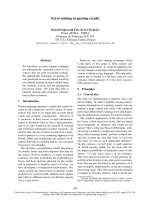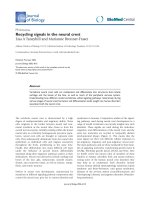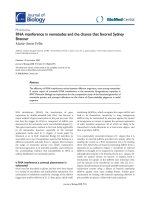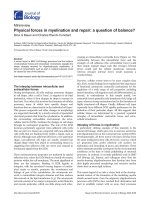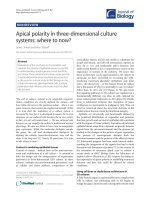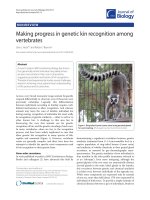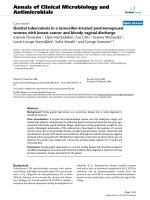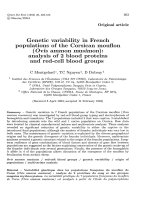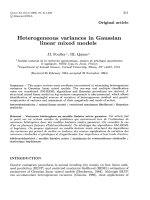Báo cáo sinh học: "Data Mining in Bioinformatics (BIOKDD)" pot
Bạn đang xem bản rút gọn của tài liệu. Xem và tải ngay bản đầy đủ của tài liệu tại đây (180.34 KB, 2 trang )
BioMed Central
Page 1 of 2
(page number not for citation purposes)
Algorithms for Molecular Biology
Open Access
Meeting report
Data Mining in Bioinformatics (BIOKDD)
Mohammed J Zaki*
1
, George Karypis
2
and Jiong Yang
3
Address:
1
Computer Science Department, Rensselaer Polytechnic Institute, Troy, NY 12180, USA,
2
Department of Computer Science, University
of Minnesota, Minneapolis, MN 55455, USA and
3
Electrical Engineering and Computer Science Department, Case Western Reserve University,
Cleveland, OH 44106, USA
Email: Mohammed J Zaki* - ; George Karypis - ; Jiong Yang -
* Corresponding author
Data Mining is the process of automatic discovery of novel
and understandable models and patterns from large
amounts of data. Bioinformatics is the science of storing,
analyzing, and utilizing information from biological data
such as sequences, molecules, gene expressions, and path-
ways. Development of novel data mining methods will
play a fundamental role in understanding these rapidly
expanding sources of biological data.
Data mining approaches seem ideally suited for bioinfor-
matics, which is data-rich, but lacks a comprehensive the-
ory of life's organization at the molecular level. The
extensive databases of biological information create both
challenges and opportunities for developing novel data
mining methods. The 6th Workshop on Data Mining in
Bioinformatics (BIOKDD) was held on August 20th,
2006, Philadelphia, PA, USA, in conjunction with the
12th ACM SIGKDD International Conference on Knowl-
edge Discovery and Data Mining. The goal of the work-
shop was to encourage KDD researchers to take on the
numerous challenges that Bioinformatics offers. The
BIOKDD workshops have been held annually in conjunc-
tion with the ACM SIGKDD Conferences, since 2001.
Additional information about BIOKDD can be obtained
online [1].
Five revised and expanded papers were selected from the
BIOKDD workshop, out of a total of 18 submissions, to
appear in Algorithms for Molecular Biology (AMB). These
papers underwent another round of external reviewing
prior to being accepted for AMB. An overview of each
paper is given below. In the paper titled Automatic Layout
and Visualization of Biclusters, Gregory A. Grothaus, Adeel
Mufti and T. M. Murali [2], present a novel method to dis-
play biclusters mined from gene expression data. The
approach allows querying and visual exploration of the
clusters/sub-matrices. The software is also available as
open-source.
In ExMotif: Efficient Structured Motif Extraction, Yongqiang
Zhang and Mohammed J. Zaki [3], describe a new algo-
rithm called EXMOTIF to extract frequent motifs from
DNA sequences. The method can mine structured motifs
and profiles which have variable gaps between different
elements. The demonstrate the efficiency of the method
compared to state-of-the-art methods, and also demon-
strate an application in mining composite transcription
factor binding sites.
In the paper Refining Motifs by Improving Information Con-
tent Scores using Neighborhood Profile Search, Chandan K.
Reddy, Yao-Chung Weng and Hsiao-Dong Chiang [4],
show how one can refine the profile motifs discovered via
Expectation Maximization and Gibbs Sampling based
methods. They search the neighborhood regions of the
initial alignments to obtain locally optimal solutions,
which improve the information content of the discovered
profiles.
In their paper, A Novel Functional Module Detection Algo-
rithm for Protein-Protein Interaction Networks, Woochang
Hwang, Young-Rae Cho, Aidong Zhang and Murali Ram-
anathan [5], describe the unexpected properties of the
protein-protein interaction (PPI) networks and their use
in a clustering method to detect biologically relevant func-
tional modules. They propose a new method called STM
Published: 11 April 2007
Algorithms for Molecular Biology 2007, 2:4 doi:10.1186/1748-7188-2-4
Received: 31 July 2006
Accepted: 11 April 2007
This article is available from: />© 2007 Zaki et al; licensee BioMed Central Ltd.
This is an Open Access article distributed under the terms of the Creative Commons Attribution License ( />),
which permits unrestricted use, distribution, and reproduction in any medium, provided the original work is properly cited.
Publish with BioMed Central and every
scientist can read your work free of charge
"BioMed Central will be the most significant development for
disseminating the results of biomedical research in our lifetime."
Sir Paul Nurse, Cancer Research UK
Your research papers will be:
available free of charge to the entire biomedical community
peer reviewed and published immediately upon acceptance
cited in PubMed and archived on PubMed Central
yours — you keep the copyright
Submit your manuscript here:
/>BioMedcentral
Algorithms for Molecular Biology 2007, 2:4 />Page 2 of 2
(page number not for citation purposes)
(signal transduction model) to detect the PPI modules,
and compare it with previous approaches to demonstrate
its effectiveness in discovering large and arbitrary shaped
clusters.
In A Spatio-temporal Mining Approach towards Summarizing
and Analyzing Protein Folding Trajectories, Hui Yang, Srini-
vasan Parthasarathy and Duygu Ucar [6], describe a
method to mine protein folding molecular dynamics sim-
ulations datasets. They describe a spatio-temporal associ-
ation discovery approach to mine protein folding
trajectories, to identify critical events and common path-
ways.
Acknowledgements
We would like to thank the program committee of the BIOKDD work-
shop, as well as the AMB external reviewers, for their help in reviewing all
the submissions.
References
1. BIOKDD: 6th SIGKDD Workshop on Data Mining in Bioinfor-
matics. [ />].
2. Grothaus GA, Mufti A, Murali T: Automatic layout and visualiza-
tion of biclusters. Algorithms for Molecular Biology 2006, 1:15.
3. Zhang Y, Zaki MJ: EXMOTIF: efficient structured motif extrac-
tion. Algorithms for Molecular Biology 2006, 1:21.
4. Reddy CK, Weng YC, Chiang HD: Refining motifs by improving
information content scores using neighborhood profile
search. Algorithms for Molecular Biology 2006, 1:23.
5. Hwang W, Cho YR, Zhang A, Ramanathan M: A novel functional
module detection algorithm for protein-protein interaction
networks. Algorithms for Molecular Biology 2006, 1:24.
6. Yang H, Parthasarathy S, Ucar D: A spatio-temporal mining
approach towards summarizing and analyzing protein fold-
ing trajectories. Algorithms for Molecular Biology 2007, 2:3.
